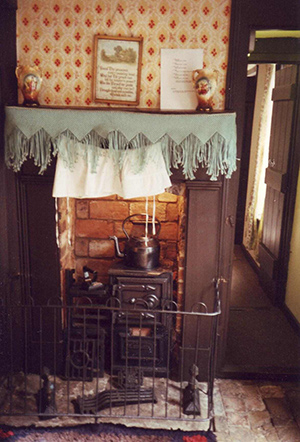 A cooking fire
The gas stove arrived at the end of the nineteenth century and transformed the way we use rooms in the urban home.
A cooking fire
The gas stove arrived at the end of the nineteenth century and transformed the way we use rooms in the urban home.
According to architectural and housing historians Roderick Lawrence and Martin Daunton, these changes had taken place before the First World War when the gas stove was installed in the scullery. The placing of the stove in the scullery, which was traditionally used for washing dishes, meant that what we called a kitchen or living-room/living-kitchen ceased to be a space for cooking.
Instead, the scullery took on the attributes of what June Freeman refers to as the ‘modern’ kitchen. It became a space for both cooking and washing-up, and sometimes for eating.
The stove has been important in changing the way we experience homes. Yet this change varied by region and by class and was not as straightforward as Daunton and Lawrence suggest. To find these variations we need to consider how rooms and stoves were actually used. By examining the lived-experience of space through oral and written testimony, we find a more complex picture of transformation.
An examination of 112 childhood memories of working-class families from around Britain looking back on the first half of the twentieth century suggests that the impact of the stove on room function occurred later in these households. The autobiographers revealed that it was not just the poorest families who lacked a gas stove at the turn of the century. Even better-off working class families described making this switch in the mid-1920s and early 1930s.
Winifred Renshaw, whose father worked in a South Yorkshire tax office, only acquired a stove in the 1920s while author Raymond Briggs’s parents replaced their range in around 1930. The comment on Winifred’s street when her parents acquired one suggests that it was rare, perhaps a sign of improved status. Briggs’ depiction of his mother as highly aspirational reinforces this view.
Moreover, in homes which did have a gas stove, the shift to the ‘modern’ kitchen for cooking and washing up was not as immediate as we might assume. In Leicester, where the town corporation claimed to have installed 41,000 gas cookers by 1904, Bel Weldon’s grandmother still preferred cooking over her open fire rather than on her stove well into the interwar period. Other families used the stove only in the summer months or for selective cooking. Winifred Renshaw’s family continued to use their range during the winter months even after they had their gas stove. In the same period, Joyce Skinner’s family used the range in their living room for boiling hot water and for baking. The rest of the cooking was done on the gas stove in the scullery.
This arrangement only lasted during the 1920s. In 1930 the Skinner’s range was removed and replaced with ‘a grate’ and the scullery became a working kitchen. Other families could only afford to heat one room. As the range was also a source of heat it was cheaper to cook on it than the gas stove. Ranges were also convenient for heating hot water in homes without gas boilers.
Use of space transformed, not only because stoves replaced kitchen ranges and open fires. Changes in dwelling design and other technologies, such as the gas or electric fire and hot water geezer, played a significant role in altering the function of the ‘kitchen’. Yet it is only by looking at actual space usage and deployment of technology that we can understand the nuances of when, and how, these changes occurred.
Rate and Review
Rate this article
Review this article
Log into OpenLearn to leave reviews and join in the conversation.
Article reviews